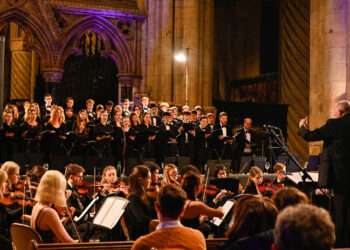 In the first of two concerts this weekend combining brass and choral music, the Durham BRASS festival took us back to one of brass music’s spiritual homes: St Mark’s Basilica in Venice, where a distinctive style of sacred music developed in the second half of the sixteenth century. The instrumentalists and singers in St Mark’s were positioned around the galleries high above the congregation, and so the composers working there wrote for multiple choirs and groups of brass instruments, allowing the sound to be batted back and forth across the great space of the basilica. This was the sound world that Durham Cathedral Choir and His Majestys Sagbutts and Cornetts brought to another great space in Durham Cathedral, although practicalities kept them firmly at ground level.
In the first of two concerts this weekend combining brass and choral music, the Durham BRASS festival took us back to one of brass music’s spiritual homes: St Mark’s Basilica in Venice, where a distinctive style of sacred music developed in the second half of the sixteenth century. The instrumentalists and singers in St Mark’s were positioned around the galleries high above the congregation, and so the composers working there wrote for multiple choirs and groups of brass instruments, allowing the sound to be batted back and forth across the great space of the basilica. This was the sound world that Durham Cathedral Choir and His Majestys Sagbutts and Cornetts brought to another great space in Durham Cathedral, although practicalities kept them firmly at ground level.
One of the best known composers of this Venetian style was Giovanni Gabrieli, and his music formed the backbone of this lovely concert programme, beginning with the sackbuts and cornetts* playing one of his canzoni – short pieces written for instruments but imitating vocal styles. This, Canzon seconda and the Canzon terza that followed later were warm and lyrical, and showed off the ability of the cornetts to mirror the human voice with their mixture of sweet-toned power and flexibility, which really came out in the little flourishes bouncing back and forth at the end of the Canzon seconda. The three cornetts had a moment to themselves in Gabrieli’s Sonata XXI, supported by organist Francesca Massey; after a sighing woody-toned opening came some exquisitely delicate light playing.
The performers moved around the cathedral during the concert, and this was at its most effective for Gabrieli’s O Magnum Mysterium when the performers were gathered at the back of the nave. The choir were sounding great all evening, giving solid and confident performances, vastly improved from when I last heard them singing this repertoire a few years ago, but the sound from the back of the cathedral where no-one has to battle against the acoustic difficulties of the tower was particularly rich, with a good balance between choir and instruments. The Alleluias at the end came tumbling out in a wave of excitement, before one of those spectacular minor cadences that are so distinctively Venetian.
One of the pieces that really epitomises Giovanni Gabrieli’s music-making in St Mark’s is the long motet In Ecclesiis, which uses four groups of choirs, soloists and instrumentalists. The soloists were excellent, particularly the three senior girls who blended together to create a resonant and powerful sound on the higher part, and the achingly beautiful harmonies piled up at the end to a glorious climax. This piece also epitomised the shortcoming of this concert though, because although it was billed as “Venetian Surround Sound”, it wasn’t really. The choir moved around the building, and the instruments played a couple of pieces from (I think) the transepts, but always stayed together in a group, so that we were never given the full stereophonic effect of what would have been separated choirs.
Giovanni Gabrieli was probably brought up by his uncle, Andrea, who held the same positions as organist and composer at St Mark’s, and he was acknowledged with a short organ solo, Intonazione del octavo tono, played by Francesca Massey on the cathedral’s chamber organ; I really enjoyed the crisp clarity of the faster runs, contrasting with the mellow mood of the piece. Another important influence on Giovanni Gabrieli was his teacher Orlando Lassus. His Missa Bell’ Amfitrit, one of his best known works, was composed in Munich, but is probably based on a Venetian song, and also uses double choir. The cathedral choir sing this mass setting fairly regularly in services, but the doubled treble line of both boys and girls, and with the addition of the sackbuts and cornetts, transformed it. There was some lovely interplay between the choirs in the Gloria, whilst the cornetts floated above, and the contrast between the full choirs and semi-chorus in the Credo was very effective.
Monteverdi’s 1610 Vespers were written before he took up his post at St Mark’s, famously forming part of his job application portfolio, but the work has become firmly associated with the Basilica. Ave Maris Stella sung this evening was stately and prayerful, with quiet power from the two boy solos.
Gabrieli had developed his polychoral writing studying with Lassus in Munich, and the style found its way from Venice back to Germany in the early seventeenth century. I really enjoyed the graceful dignity of the three sackbuts playing Daniel Speer’s Sonate a3, and their rich lower notes drifting through from the transept in Scheidt’s Canzona super Cantionem Gallicam was particularly atmospheric. For Scheidt’s dramatic Galliard Battaglia, we were given something closer to the Venetian effect, with the sackbuts in the middle of the nave, and cornetts moving to the side aisles, the sound passing back and forth with fluid cornet runs and majestic sackbut chords echoing down the nave.
Praetorius’s Magnificat quinti toni made a dramatic end to the concert, with the choir really giving it their all here, particularly the trebles. The offset syncopations bounced back and forth between the choirs, and there were some nice contrasting passages of lightness before the final build ups. This will have been the last concert for some of the children and student choral scholars as well as James Lancelot’s final concert conducting the choir, so it was fitting that it ended in such a spectacular way.

A note on the instruments
Sackbuts (or sagbutts) are brass instruments, in a variety of sizes played with slides; the predecessors of the modern trombone.
Cornetts: are a conical wooden pipe, with a leather covering. They are played like brass instruments with a cup-shaped mouthpiece, and fingered on holes like a recorder.








